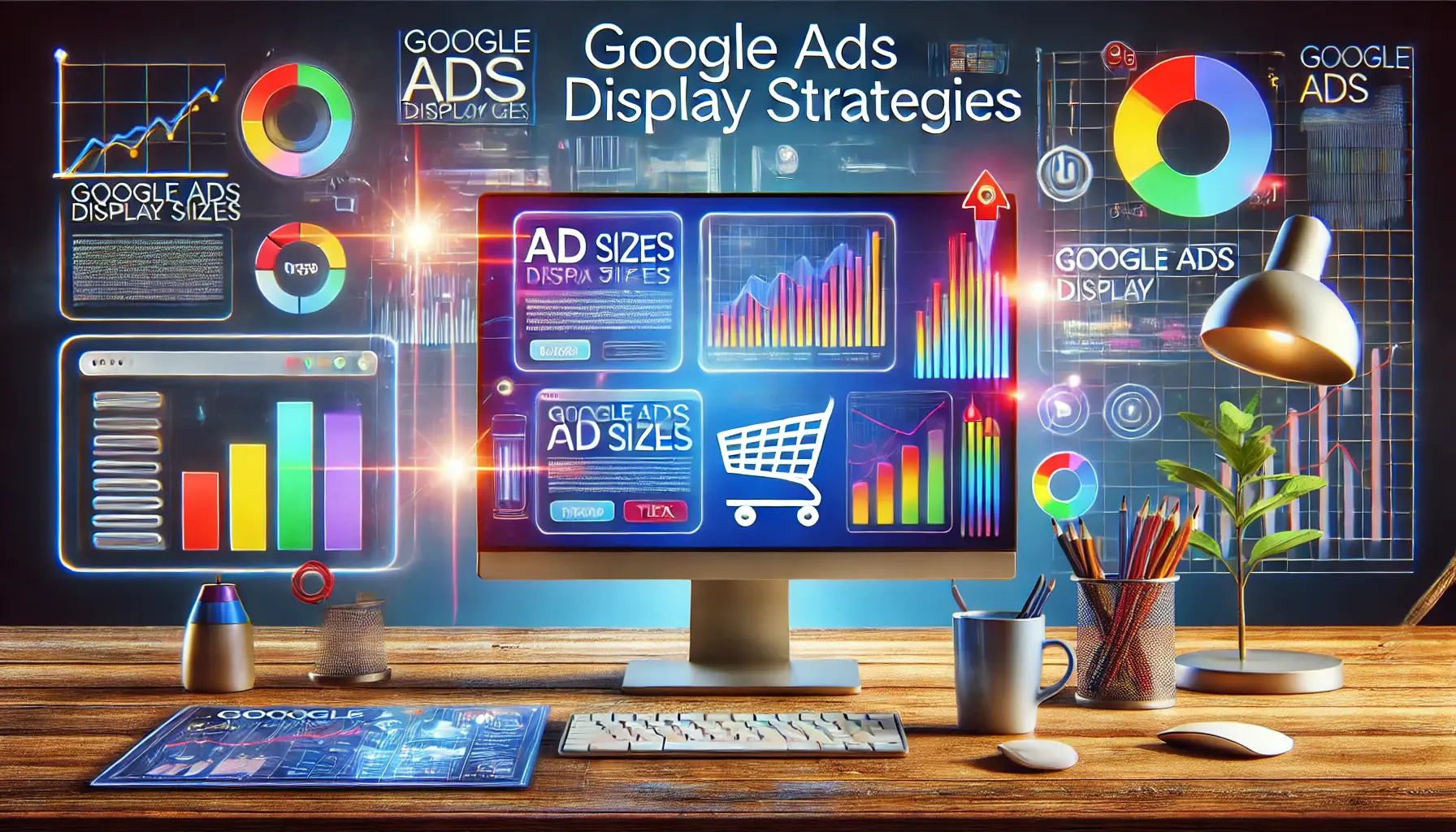But for actually serving those ads on Google, one thing really makes or breaks your campaign: ad copy.
It’s not about having the flashiest design or bidding on the highest keyword; it’s about crafting the right message to connect with the audience and entice them to take action.
Whether you are an experienced marketer or just starting with Google Ads, learning to write compelling ad copy can make a huge difference in CTRs and significantly improve the performance of your campaigns.
In this article, we dive deep into the best practices for ad copywriting in Google Ads.
In this section, we are going to cover how to create attention-grabbing headlines, descriptions that convert, and how to test and perfect your ad copy for the best results.
By the end of this article, you will learn how to write captivating ad copy that resonates with your target audience and helps you achieve your paid advertising goals in Google Ads.
- Understanding the Basics of Ad Copywriting in Google Ads
- Writing Seductive Ad Headlines to Improve CTR
- Craft Compelling Descriptions to Boost Conversions
- How to Write the Best Ad Copy, Based on Google Ads Campaign Type
- Testing and Optimizing Your Ad Copy for Peak Performance
- Master Ad Copywriting to Succeed on Google Ads
- Google Ads Ad Copywriting FAQs
Understanding the Basics of Ad Copywriting in Google Ads
Before diving into the more advanced techniques, it’s important to first understand the foundational elements of ad copywriting in Google Ads.
Good ad copy is not just about sounding good; it’s about communicating an effective message that matches the user’s search intent while simultaneously encouraging them to click on your ad.
Whether people are actively searching for what you offer or just browsing, your ad copy plays a huge role in the success of your campaign.

Workspace showcasing ad copywriting in Google Ads, with creative tools and digital marketing elements.
What is Ad Copywriting in Google Ads?
Ad copywriting in Google Ads involves writing the text that appears in your search, display, or video ads.
This includes the headline, description, and any call-to-action (CTA) in the ad.
Each of these elements has limited space in Google Ads, so your goal is to create attractive, concise messages that respond to the needs or wants of your target audience.

Workspace illustrating the role of good ad copy in marketing success, with tools for drafting and measuring performance.
The Significance of Good Ad Copy
Good ad copy can make or break your Google Ads campaign.
With only a few seconds to capture attention, your copy must be clear, relevant, and persuasive.
Effective ad copywriting boosts your CTRClick-Through Rate, a metric that measures the percentage of clicks an ad receives relative to its impressions., a critical factor in determining your ad’s Quality ScoreA Google Ads metric that reflects the relevance and quality of your ad, keywords, and landing page..
A higher Quality Score lowers the cost for higher ad positions.
Beyond cost efficiency, ad copy that resonates with your audience helps drive them deeper into your sales funnel, leading to more sales or leads for your business.

Workspace showcasing the critical elements of high-converting ads, including clarity, value proposition, and relevance.
Key Elements of a High-Converting Ad
In writing high-converting ad copy, you need to focus on a few key elements:
- Relevance: Ensure your ad copy matches what the user is looking for. Use relevant keywords that align with their search intent.
- Clarity: Avoid using jargon or overly complex language. Keep it simple and straightforward.
- Value Proposition: Clearly explain what makes your offer unique or better than the competition.
- Call-to-Action (CTA): Include a clear and persuasive CTA that guides the user on what to do next.
By focusing on these key factors, you can create ad copy that does more than just attract clicks—it drives meaningful results for your business.
Good ad copy aligns with user search intent and encourages action, significantly impacting the performance of Google Ads campaigns.

Workspace illustrating the process of writing compelling ad headlines to improve click-through rates (CTR).
Writing Seductive Ad Headlines to Improve CTR
This is what the users are going to see, and therefore it will be the most important piece of your ad copywriting in Google Ads.
A great headline can capture attention, convey value, and invite users to click through to learn more.
A poorly written headline, no matter how relevant or useful your ad may be, might get passed over in a heartbeat.
In a competitive digital landscape, ad headline optimization is key to improving CTR and the success of your campaign in general.

Workspace dedicated to the process of writing compelling ad headlines with focus on creativity and clarity.
How to Craft Compelling Ad Headlines
You should focus on relevancy, clarity, and emotional appeal when crafting compelling ad headlines.
Here are some key strategies:
- Include Keywords: Your primary keyword should feature in your headline. This not only helps with relevance but also boosts your ad’s visibility by matching user queries.
- Highlight USPs: What is unique about your offering? Highlight your value proposition in the headline to attract users’ attention. Whether it’s a special discount, fast delivery, or a unique feature, make it clear.
- Keep It Short and Punchy: Google allows up to 30 characters per headline, so every word counts. Ensure your headline is concise, easy to understand, and impactful.
- Use Action-Oriented Language: Encourage users to take immediate action with verbs like ‘Buy,’ ‘Shop,’ ‘Get,’ or ‘Discover.’ Action words create a sense of urgency or excitement.

Workspace illustrating the use of power words in ad copy to increase engagement and interaction.
Using Power Words to Increase Engagement
Incorporating ‘power words’—emotionally charged or persuasive words—into your ad headlines can significantly boost engagement.
Power words raise curiosity, excitement, or a sense of urgency.
Here are some examples of power words that can enhance your ad copywriting:
- Exclusive: People like things they perceive to be scarce or unavailable to all. Words related to urgency, like ‘exclusive’ or ‘limited time,’ work well.
- Free: Many clients are tempted by offers like a free trial or consultation. Use this word where appropriate and within the boundaries of your ad strategy.
- Guaranteed: Adding a guarantee to your headline can build trust with your audience, especially if your offer involves a commitment or investment.
- Instant: People love speed and convenience. Emphasizing instant access or quick delivery can help your ad stand out.

Workspace illustrating best practices for crafting ad headlines with a focus on length and relevance.
Headline Best Practices: Length and Relevance
When crafting headlines, length and relevance are a delicate balance.
While Google Ads allows headlines of up to 30 characters, you don’t have to use the entire space if it compromises clarity.
Follow these best practices to ensure your headlines are optimized for performance:
- Be Concise: Use the least number of words to convey your message effectively. Shorter headlines are easier to read, especially on mobile devices.
- Ensure Relevance: Always align your headlines with the user’s search query and the content of your ad. If the headline seems irrelevant, users are unlikely to click it.
- Test Multiple Variations: A/B testing different headline versions can pay off. Often, a small tweak can bring substantial CTR changes.
- Leverage Dynamic Keyword Insertion (DKI): This advanced feature in Google Ads automatically updates your ad headline to include the exact keywords the user searched for. It makes your ad hyper-relevant to the user’s query.
Optimizing ad headlines is an ongoing process, but once you nail it, the effect on your click-through rate and ad performance will be significant.
Combine keyword relevance with emotional appeal and clear messaging, and you’ll have a headline that grabs attention and delivers results.
Effective headlines include keywords, emphasize USPs, and use action-oriented language to drive higher click-through rates.
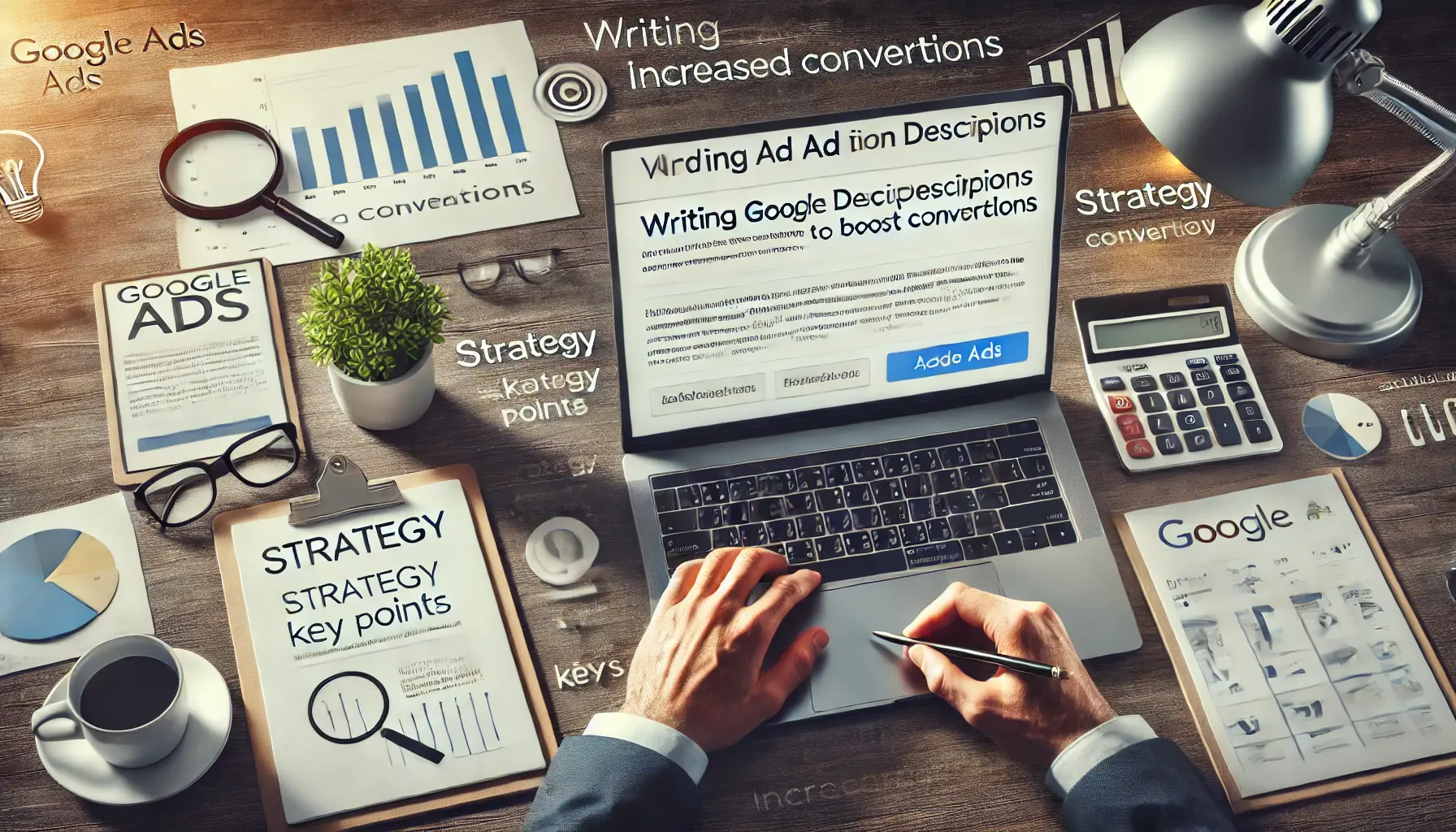
Workspace illustrating the process of writing compelling ad descriptions to boost conversions.
Craft Compelling Descriptions to Boost Conversions
While headlines drive attention, the actual description is where you build the conviction for users to take action.
In ad copywriting for Google Ads, your description text gives you room to explain your offer and persuade users why they should care.
Well-crafted ad descriptions not only increase the number of clicks but also improve conversion rates by addressing users’ needs and including a direct call to action.
Users spend only a few seconds scanning each ad to decide whether or not to click.
Therefore, your description should be concise and impactful.

Workspace illustrating the process of structuring ad descriptions for maximum impact and engagement.
Structuring the Descriptions for Impact
Here are some tips for structuring ad descriptions effectively:
- Strong Value Proposition: Start your description with the main benefit or unique selling point (USP) of your product or service. This should immediately indicate to users why they should choose you over the competition.
- Use Clear, Actionable Language: Your description must be straightforward and easy to understand, containing simple language that guides the user to take action. Verbs such as ‘discover,’ ‘learn,’ ‘buy,’ or ‘save’ work well.
- Strong Call-to-Action: Conclude your description with a clear call-to-action that invites users to take further action, such as ‘Shop Now,’ ‘Sign Up,’ or ‘Get Started.’
- Highlight Key Features or Offers: If you are running a special promotion, free shipping, or a limited-time offer, mention it in the description. Special offers create urgency and encourage users to take action.

Workspace illustrating the process of incorporating clear and action-driven CTAs in ads for higher conversions.
Incorporating Call-to-Actions (CTAs) Effectively
The call-to-action is one of the most important elements of your ad copywriting in Google Ads.
It guides users toward making a decision.
To ensure your CTA is effective, it should be:
- Clear and Direct: Avoid ambiguous CTAs like ‘Click Here.’ Instead, use specific phrases such as ‘Get Your Free Quote’ or ‘Start Your Free Trial’ so users know exactly what action to take.
- Aligned with Your Offer: The CTA should relate to the offer you’re promoting. For example, for encouraging free trials, use ‘Try It for Free’ as your CTA.
- Urgent: Creating urgency prompts users to act quickly. Words like ‘Limited Time Offer’ or ‘Shop Now’ encourage immediate action.
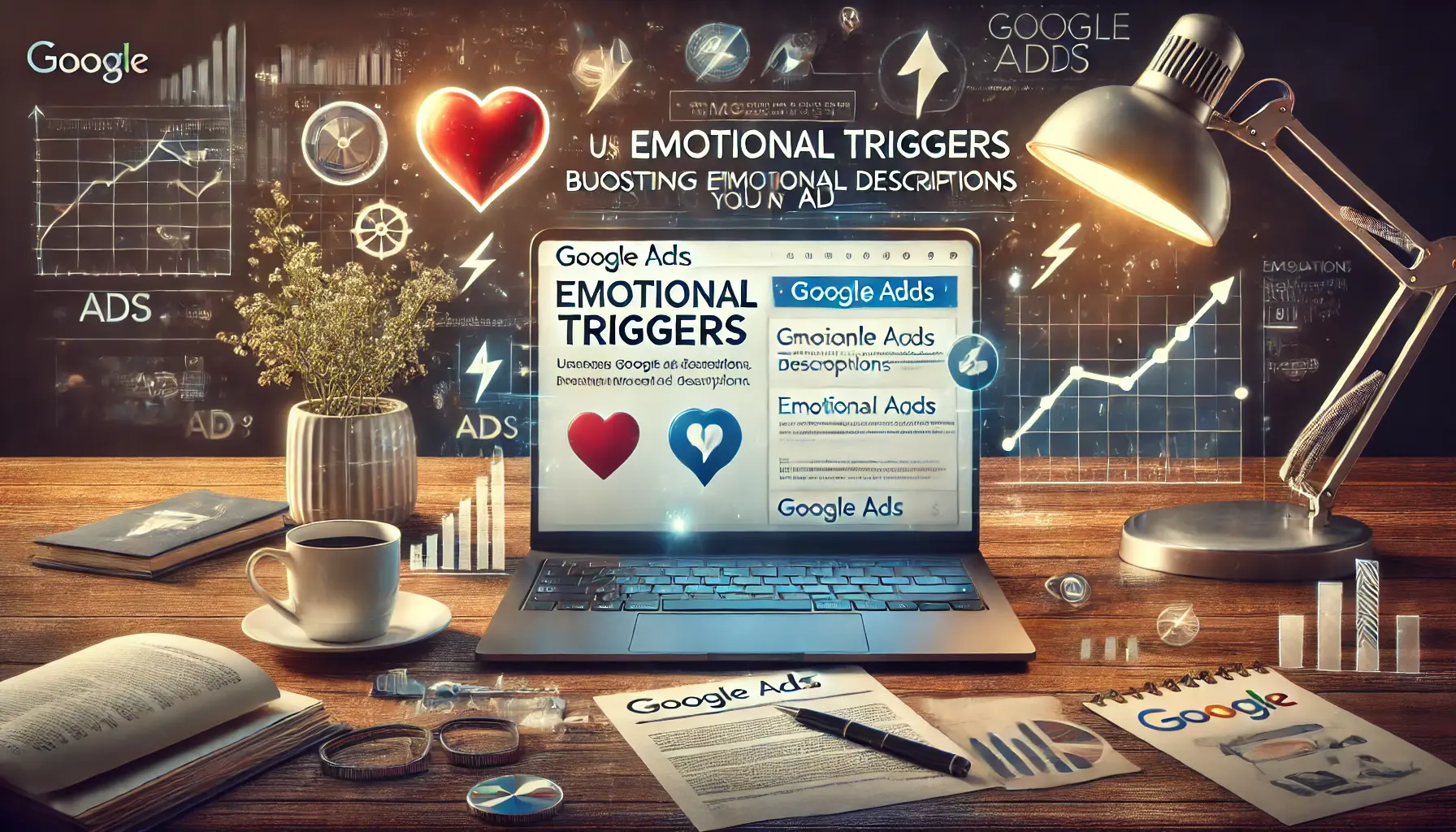
Workspace illustrating the use of emotional triggers in ad descriptions to increase engagement and conversions.
Using Emotional Triggers in Descriptions
Adding emotional appeal to your ad copy can create a stronger connection with users.
Consider using the following tactics:
- Excitement: Use energetic language to build excitement around your offer. Phrases like ‘Don’t Miss Out!’ or ‘Limited Time Only!’ create a sense of urgency.
- FOMO (Fear of Missing Out): Imply scarcity or exclusivity, so users feel like they could miss out on something special. Words like ‘Exclusive’ or ‘Limited Stock’ are effective.
- Desire: Paint a picture of what the user will gain by choosing your product. For example, ‘Transform Your Home Today’ or ‘Achieve Your Fitness Goals’ taps into users’ desires for improvement.

Workspace illustrating common mistakes in ad descriptions, emphasizing caution and clarity for effective ads.
Common Mistakes to Avoid in Ad Descriptions
Writing ad copy descriptions might seem straightforward, but there are common mistakes that can reduce effectiveness.
Avoid these pitfalls:
- Being Too Vague: Steer clear of general descriptions that don’t communicate any specific benefit. Instead of saying ‘Great Service,’ explain why it’s great.
- Overcomplicating the Message: Use clear, simple language. Users should quickly understand the value without being overwhelmed by complex wording.
- Neglecting the CTA: Always include a strong call-to-action. Failing to guide users on what to do next leaves them unsure of how to proceed.
By structuring your ad descriptions effectively, using emotional triggers, and avoiding common mistakes, you can significantly improve your ad’s performance.
Focus on the user’s needs and create a description that not only attracts clicks but also drives conversions.
Well-crafted ad descriptions should focus on a strong value proposition, clear language, and a powerful call-to-action to increase conversions.

Workspace illustrating how to tailor ad copy based on the type of Google Ads campaign for better performance.
How to Write the Best Ad Copy, Based on Google Ads Campaign Type
Writing ad copy in Google Ads depends heavily on the type of campaign you’re running.
Whether it’s a Search, Display, Video, or Shopping campaign, each has specific requirements and goals.
Tailoring your message to fit the specific campaign type will make your ad copy more relevant to your targeted audience and ensure maximum performance.

Workspace illustrating how to tailor Search Ads to match user intent for better engagement.
Search Ads: Writing to User Intent
Search ads are text ads that appear in Google’s search results.
They are triggered by user queries, which means your ad copy needs to align with the user’s search intent.
Here are some key strategies for writing search ad copy:
- Focus on Relevance: Match your headline and description to the keywords the user searched for. This enhances your ad’s Quality Score and relevance, making it more likely for users to click.
- Highlight Benefits Immediately: Many searchers want an immediate solution. Your ad copy should communicate the main benefit or solution you offer within the first few lines.
- DKI (Dynamic Keyword Insertion): Automatically inserting the exact keyword the user searched for into your ad ensures it’s highly relevant to their query.
- Use Clear CTAs: Direct users to specific actions like ‘Buy Now,’ ‘Learn More,’ or ‘Get a Quote.’

Workspace illustrating the process of balancing visuals and text in Display Ads for maximum impact.
Display Ads: Juggling Visuals with Text
Display ads run across Google’s Display Network and are visually driven.
These ads appear on various websites, so your ad copy needs to complement the visuals without overpowering them.
Here’s how to optimize your display ad copy:
- Keep It Concise: Display ads contain very little text. Focus on writing short, impactful messages that can be read in just a few seconds.
- Support the Visuals: Your ad copy should enhance the message conveyed by the image. Ensure the visuals and text work together to deliver one clear message.
- Highlight Key Offers: If you’re running a special promotion, such as a sale or discount, make this the focus of your display ad copy.
- Compelling CTAs: Just like search ads, your display ad copy should include strong CTAs, such as ‘Shop Now’ or ‘Claim Your Offer.’

Workspace illustrating the process of writing engaging scripts for video ads, combining creativity and video production.
Video Ads: Crafting Engaging Scripts
Video ads, often used on platforms like YouTube, allow for more creativity but require scripts that engage viewers quickly.
The first few seconds are critical for preventing viewers from skipping your ad.
Here’s how to write effective video ad scripts:
- Hook Viewers Immediately: The first 5-10 seconds of your video ad are vital. Use this time to grab attention with a bold statement, question, or eye-catching visual.
- Tell a Story: Video ads allow you to tell a more complete story. Use your script to take viewers on an emotional journey or solve a problem they care about.
- Include Subtitles: Many users watch videos without sound, so adding subtitles ensures your message gets across even if the audio is off.
- Strong CTA at the End: End your video ad with a clear, strong call-to-action that directs viewers on what to do next.

Workspace illustrating the process of highlighting key product information in Shopping Ads to drive conversions.
Shopping Ads: Highlighting Key Product Information
Shopping ads feature an image, product title, price, and merchant name.
Much of the information is pulled automatically, but optimizing your product feed and descriptions can greatly improve performance:
- Optimize Product Titles: Ensure that product titles are descriptive and include relevant keywords. This helps users find exactly what they’re searching for.
- Use High-Quality Images: An attractive image can be the deciding factor in whether a user clicks on your shopping ad.
- Price Competitively: Users often compare prices across sellers. Competitive pricing increases the chances of clicks and conversions.
- Include Key Features in Descriptions: While the product title may be limited, the product description provides more space to highlight key features, specifications, or benefits.
By tailoring your ad copywriting strategy to each specific Google Ads campaign type, you can ensure that your ads perform better, resonate with the right audience, and drive more conversions.
Each ad format comes with its own set of challenges and opportunities.
Mastering how to optimize your ad copy for each is essential to your campaign’s success.
Tailor your ad copy based on the campaign type, whether it’s Search, Display, Video, or Shopping ads, to maximize relevance and performance.
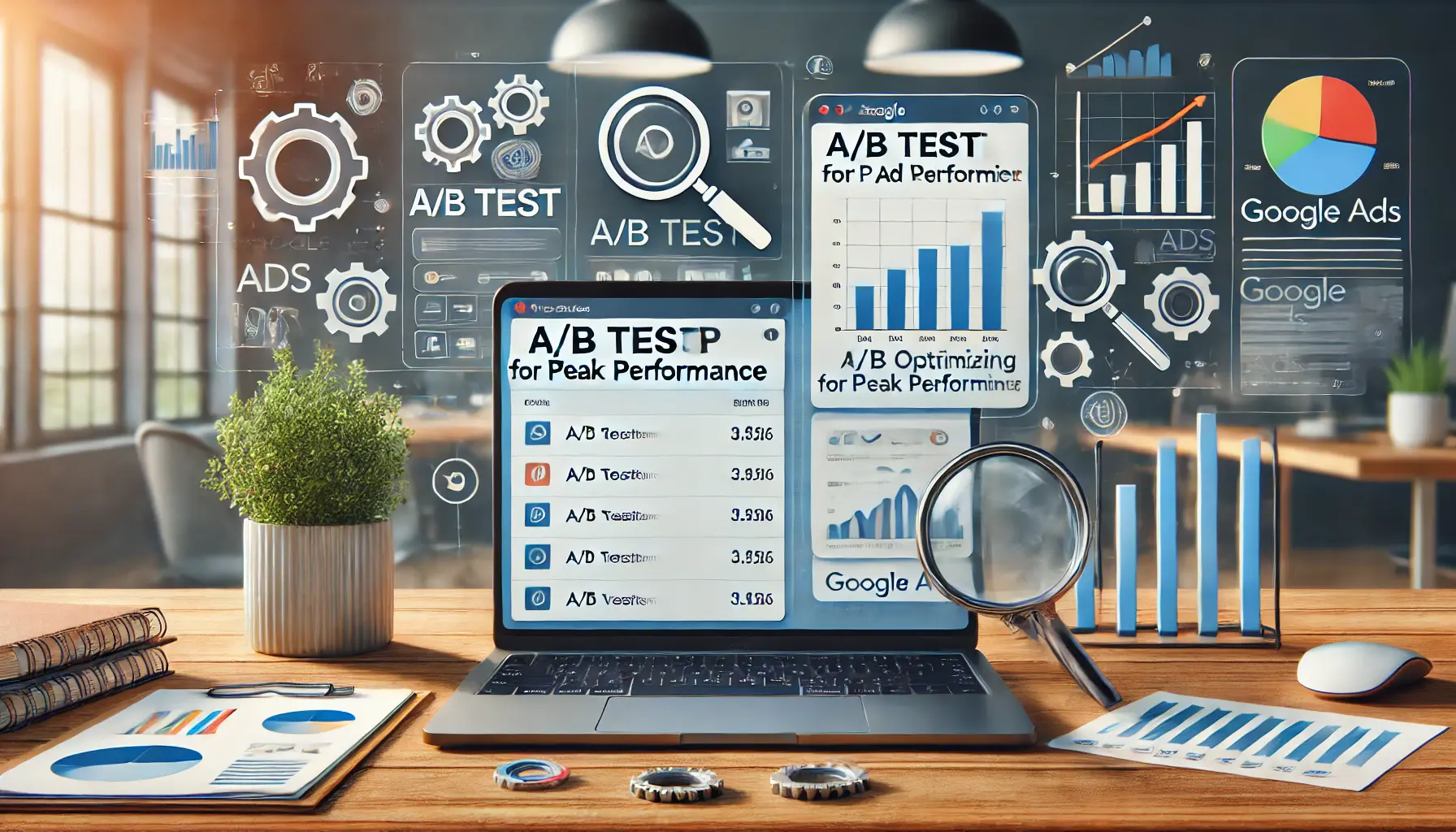
Workspace illustrating the process of testing and optimizing ad copy to achieve maximum performance and conversions.
Testing and Optimizing Your Ad Copy for Peak Performance
Even the most brilliant ad copywriting needs constant revising to yield the best results.
Google Ads offers a variety of tools and methods to help you test and improve your ad copy over time.
By utilizing performance analysis and A/B testingA method of comparing two versions of an ad or webpage to determine which performs better., you can discover which ad variant resonates better with your target audiences, leading to better CTR and conversions.
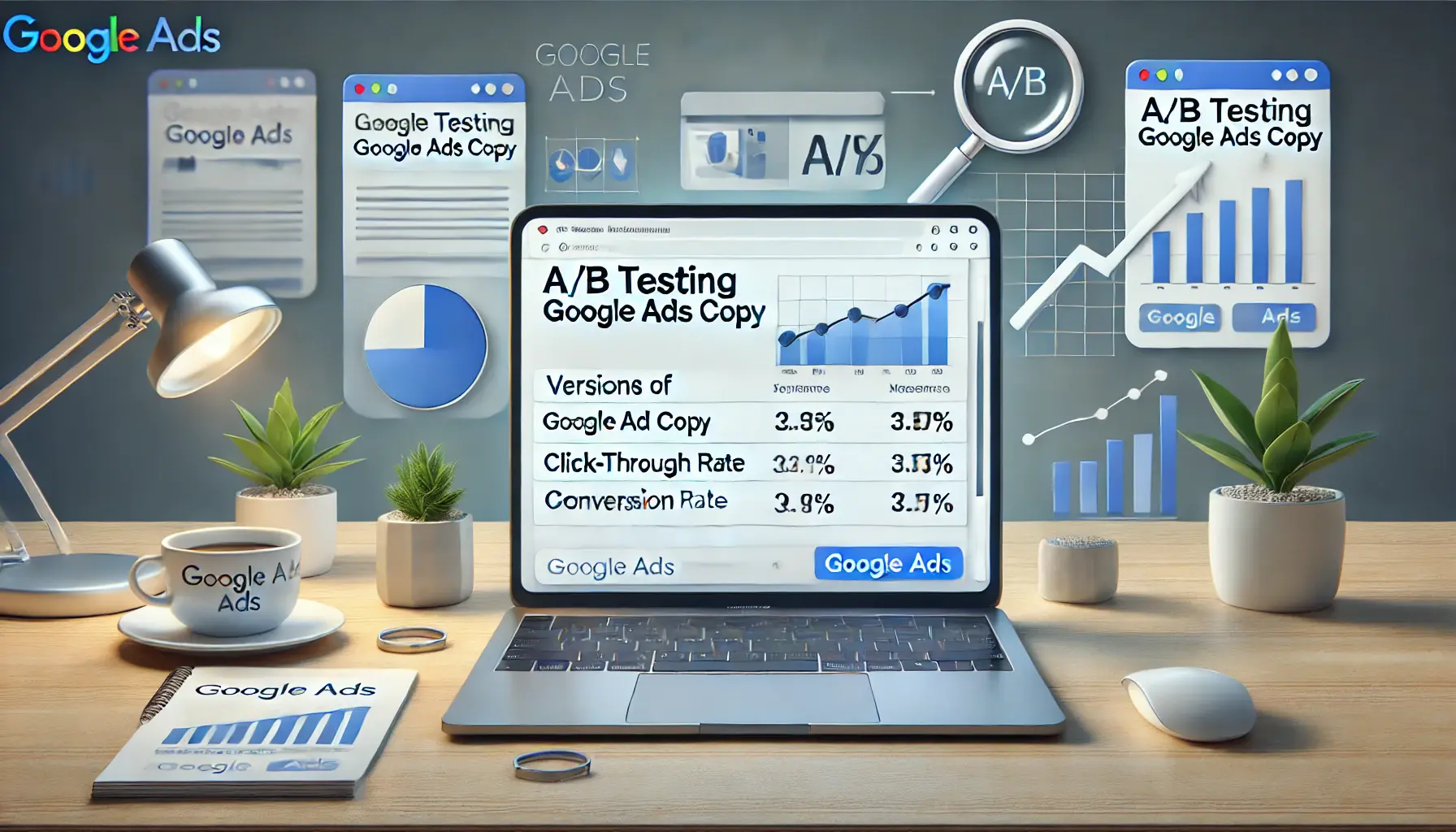
Workspace illustrating the process of A/B testing ad copy for improved performance and optimization.
A/B Testing Your Google Ads Copy
A/B testing, also known as split testing, is a surefire way to determine what works and what doesn’t in your ad copy.
This involves running at least two variants of your ad to identify the better-performing version.
Here’s how to conduct A/B testing effectively:
- Test One Element at a Time: Focus on testing one element at a time, whether it’s the headline, description, or CTA. This helps you accurately attribute performance improvements to specific changes.
- Significant Variations: Ensure that each version you test has meaningful differences. For example, test a short headline versus a longer one, or compare CTAs like ‘Shop Now’ versus ‘Get Started.’
- Monitor Performance Metrics: When analyzing A/B test results, focus on metrics such as CTR, conversion rate, and Quality Score. These metrics will reveal which ad copy performs best.
- Give Sufficient Testing Time: Allow your tests to run for a sufficient period to gather reliable data. Tests that run too briefly may not provide accurate insights.
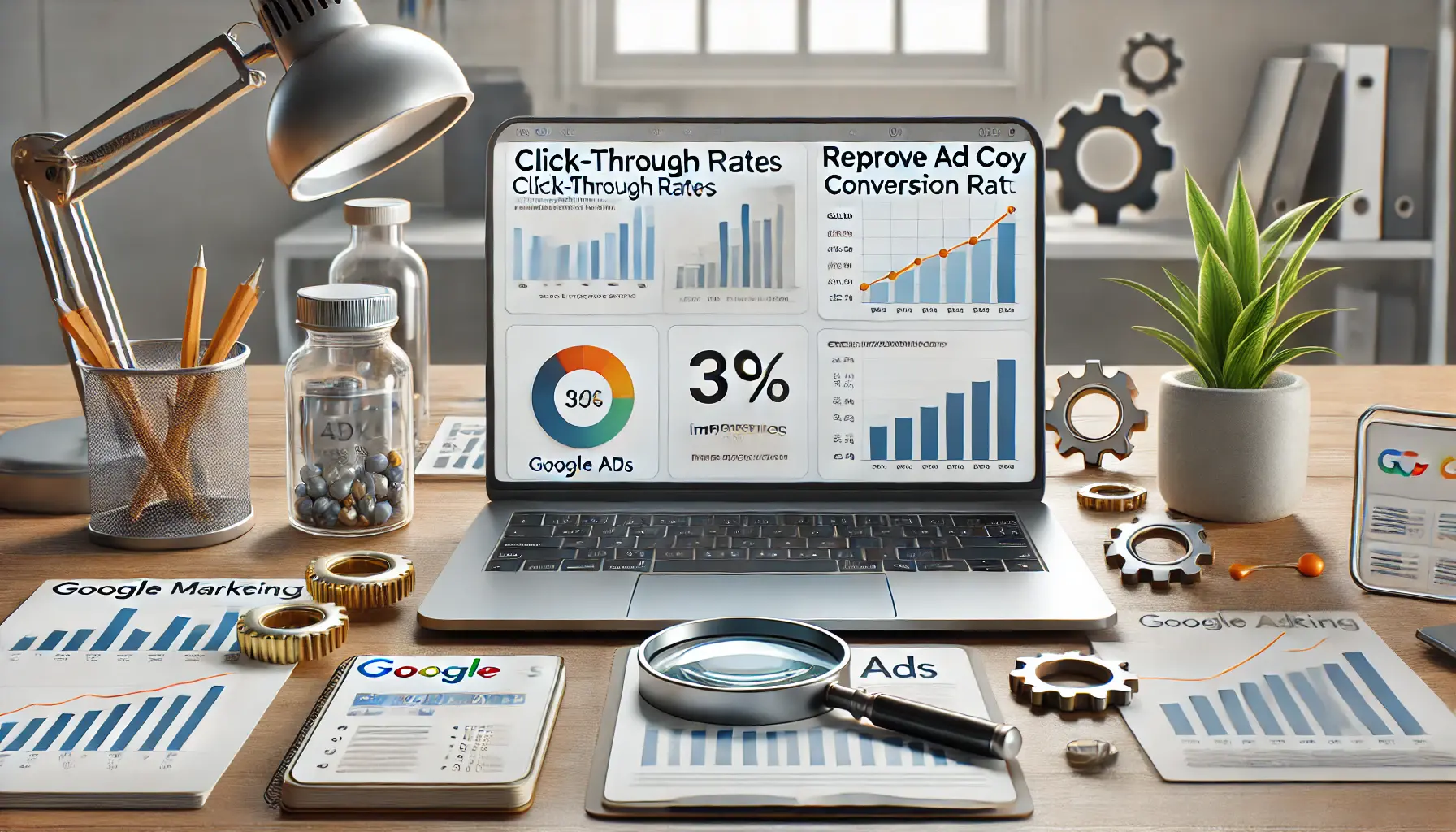
Workspace illustrating the process of analyzing performance metrics to refine and improve ad copy.
Analyzing Performance Metrics to Improve Copy
Regularly analyzing performance metrics helps you identify areas where your ad copy may need improvement.
Here are key metrics to monitor:
- Click-Through Rate (CTR): A high CTR indicates that your ad copy resonates with users and entices them to click. If your CTR is low, consider revising your headlines or CTAs to make them more engaging.
- Conversion Rate: While CTR shows how well your ad attracts clicks, conversion rate tells you how effectively your ad drives valuable actions like sales or sign-ups. If your conversion rate is low, it could indicate that your ad copy isn’t aligned with your landing page or offer.
- Quality Score: Google measures the relevance of your ad through the Quality Score. A higher score can lower your cost-per-click (CPC) and improve ad positioning. Regularly review your Quality Score to ensure your ad copy is optimized for relevance and user experience.
- Impression Share: This metric indicates how often your ad appears compared to the total available impressions. A low impression share could suggest that your ad copy isn’t relevant to your audience or that your bids are too low.

Workspace illustrating the use of Google’s Responsive Search Ads (RSAs) to optimize ad performance.
Using Google’s Responsive Search Ads (RSAs)
Responsive Search Ads (RSAsResponsive Search Ads, which allow multiple headlines and descriptions to be tested automatically by Google.) allow you to input multiple headlines and descriptions, and Google automatically tests different combinations to find the best-performing ads.
Here’s how to get the most from RSAs:
- Provide Many Variants: Google allows up to 15 headlines and 4 descriptions. The more variations you provide, the more combinations Google can test to optimize your ads.
- Ensure Consistent Messaging: Since Google will mix and match different headlines and descriptions, ensure that each element can stand alone or work together to create a cohesive message.
- Leverage Performance Insights: Google provides insights into which headline and description combinations perform best. Use this data to refine your future ad copy.
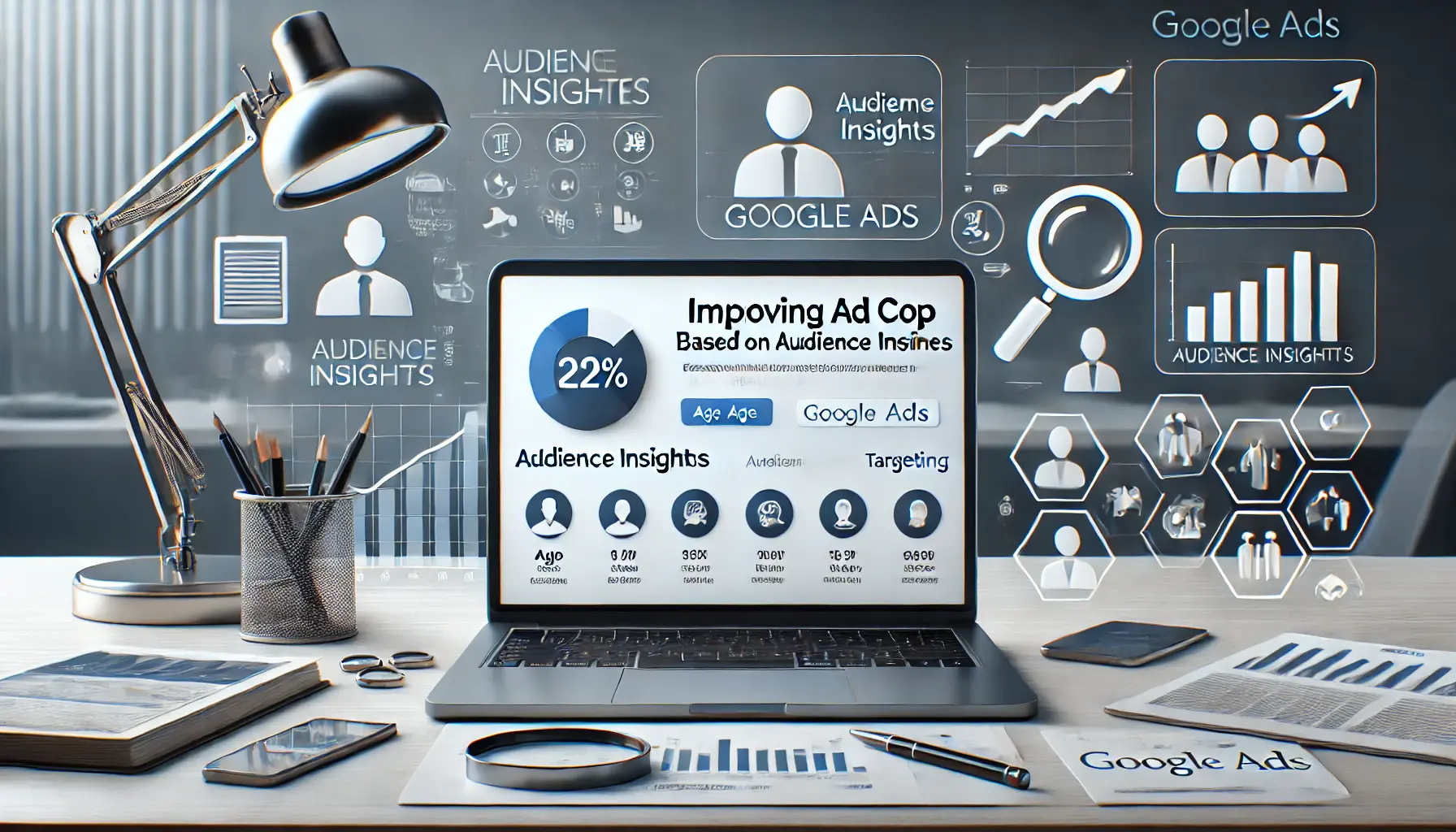
Workspace illustrating the use of audience insights to refine ad copy and boost performance.
Improving Copy Based on Audience Insights
Understanding your audience is critical for crafting ad copy that resonates.
Google Ads provides detailed audience insights that can help you fine-tune your messaging.
Here’s how to use audience data to improve your ads:
- Demographic Data: Review demographic data, such as age, gender, and location, to tailor your ad copy to the interests and needs of specific audience segments.
- Device Preferences: Check which devices your audience uses to view your ads. If mobile traffic is higher, ensure your ad copy is concise and optimized for smaller screens.
- Behavioral Insights: Analyze user behavior to understand what motivates your audience. Use these insights to create ad copy that speaks directly to their needs and preferences.
By implementing A/B testing, analyzing performance metrics, utilizing responsive ads, and applying audience insights, you can continuously optimize your ad copy for peak performance, resulting in greater efficiency and conversion potential.
Regular A/B testing and performance analysis are key to identifying high-performing ad copy variations for optimal campaign success.

Workspace illustrating the mastery of ad copywriting for improved performance on Google Ads.
Master Ad Copywriting to Succeed on Google Ads
Writing effective ad copy in Google Ads is all about strategy, testing, and iterative refinement.
In this article, we have highlighted the best practices for ad copywriting that resonates with your target audience, leads to better CTRs, and drives conversions.
Each step plays a vital role in constructing high-performing ads, depending on the type of campaign you are running, whether it’s Search, Display, Video, or Shopping ads.
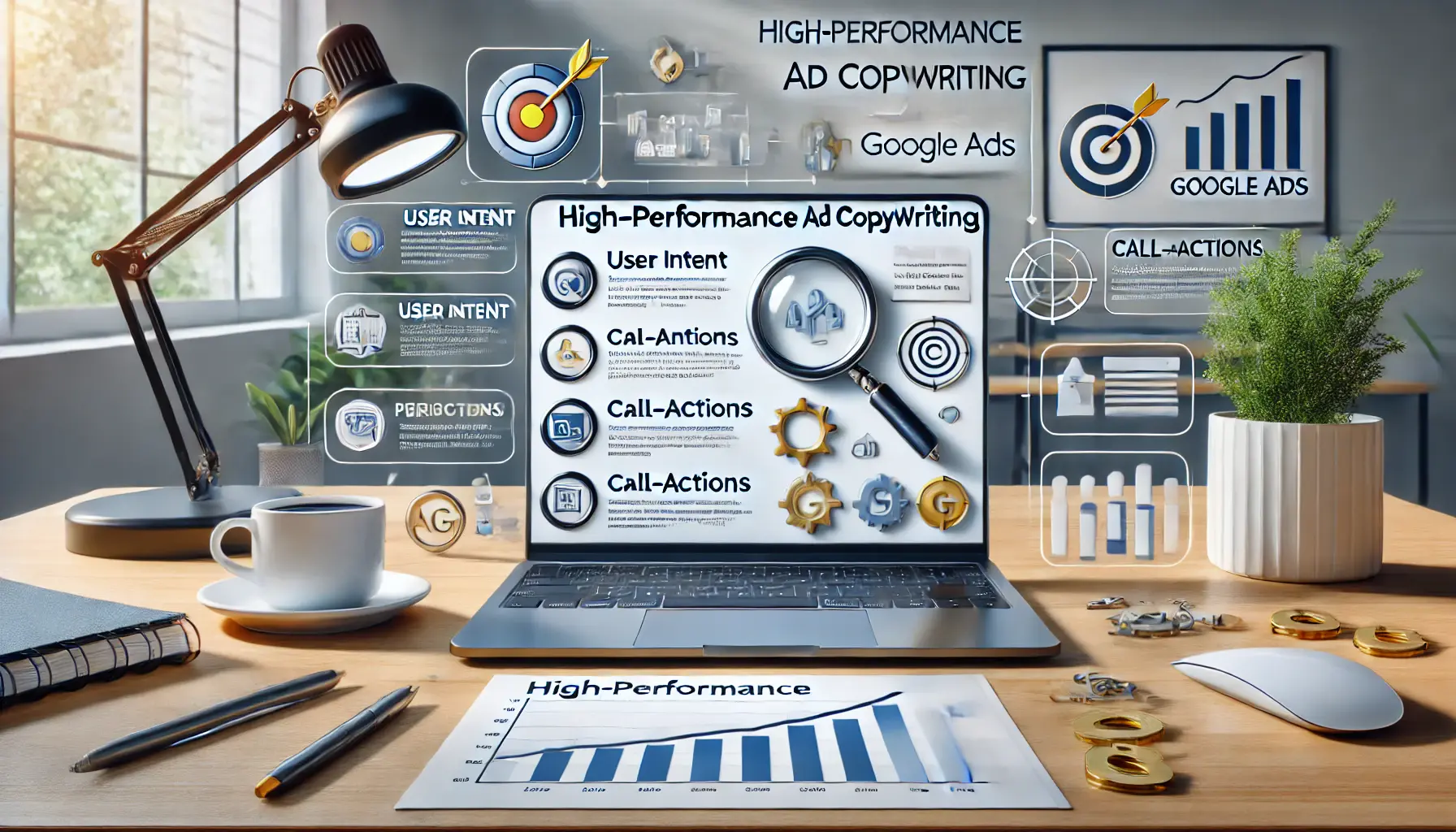
Workspace illustrating the key takeaways for crafting high-performance ad copy for Google Ads.
Key Takeaways for High-Performance Ad Copywriting
The following key takeaways outline the most critical strategies to consider when optimizing your ad copywriting on Google Ads:
- Understand User Intent: Tailor your ad copy to match audience intent. For search ads, ensure that your headline and descriptions align with the exact keyword users are searching for. This will make your ad more relevant to searchers and more likely to get clicks.
- Use Seductive CTAs: Regardless of the ad format, use clear and action-oriented CTAs such as ‘Buy Now,’ ‘Learn More,’ or ‘Sign Up Today.’ For example, display ads should be concise, and visuals should play a supporting role. Video ads should tell an engaging story with a strong CTA.
- Test and Refine Constantly: A/B testing, performance metrics, and Google’s Responsive Search Ads (RSAs) are key to finding out what works best. Continuously test variations of your ad copy to optimize performance and conversions.

Workspace illustrating the importance of testing and using data-driven insights to optimize ad copy performance.
The Role of Testing and Data-Driven Insights
One of the most important aspects of successful ad copywriting is the ability to test and refine ads over time.
Utilize A/B testing and regularly review key performance metrics, such as CTR, conversion rate, and Quality Score, to fine-tune your ads and ensure they perform at their best.
Additionally, Google RSAs allow you to input multiple variations of your ad copy, which Google automatically tests to determine the best-performing combinations.
By leveraging audience insights such as demographic data and device preferences, you can craft personalized messages for specific audience segments, resulting in more impactful interactions and higher conversion rates.
Understanding user intent, using emotional triggers, testing variations, and refining based on performance data are all essential steps to creating ad copy that captures attention and drives meaningful results for your business.
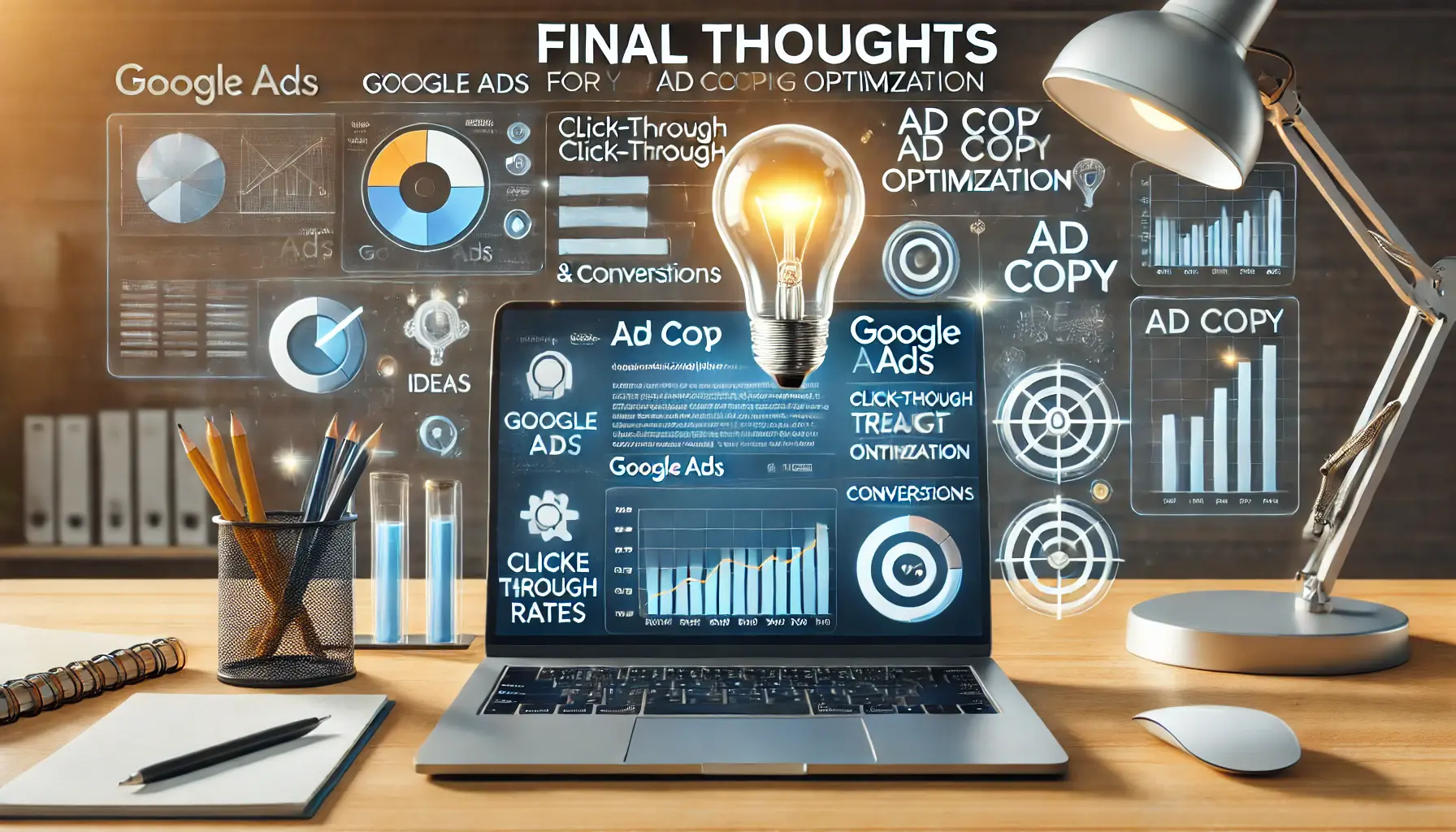
Workspace illustrating the final thoughts and culmination of strategies for optimizing ad copywriting.
Final Thoughts on Ad Copywriting Optimization
As the digital space becomes increasingly competitive, the ability to constantly optimize your ad copywriting is one of the key differentiators that can set you apart from the competition.
By applying the strategies discussed throughout this article, you can achieve better performance and higher ROI with your Google Ads campaigns, ensuring your business remains ahead in the competitive landscape.
Consistently refining ad copy through strategy and data-driven insights is critical for standing out in the competitive digital space.
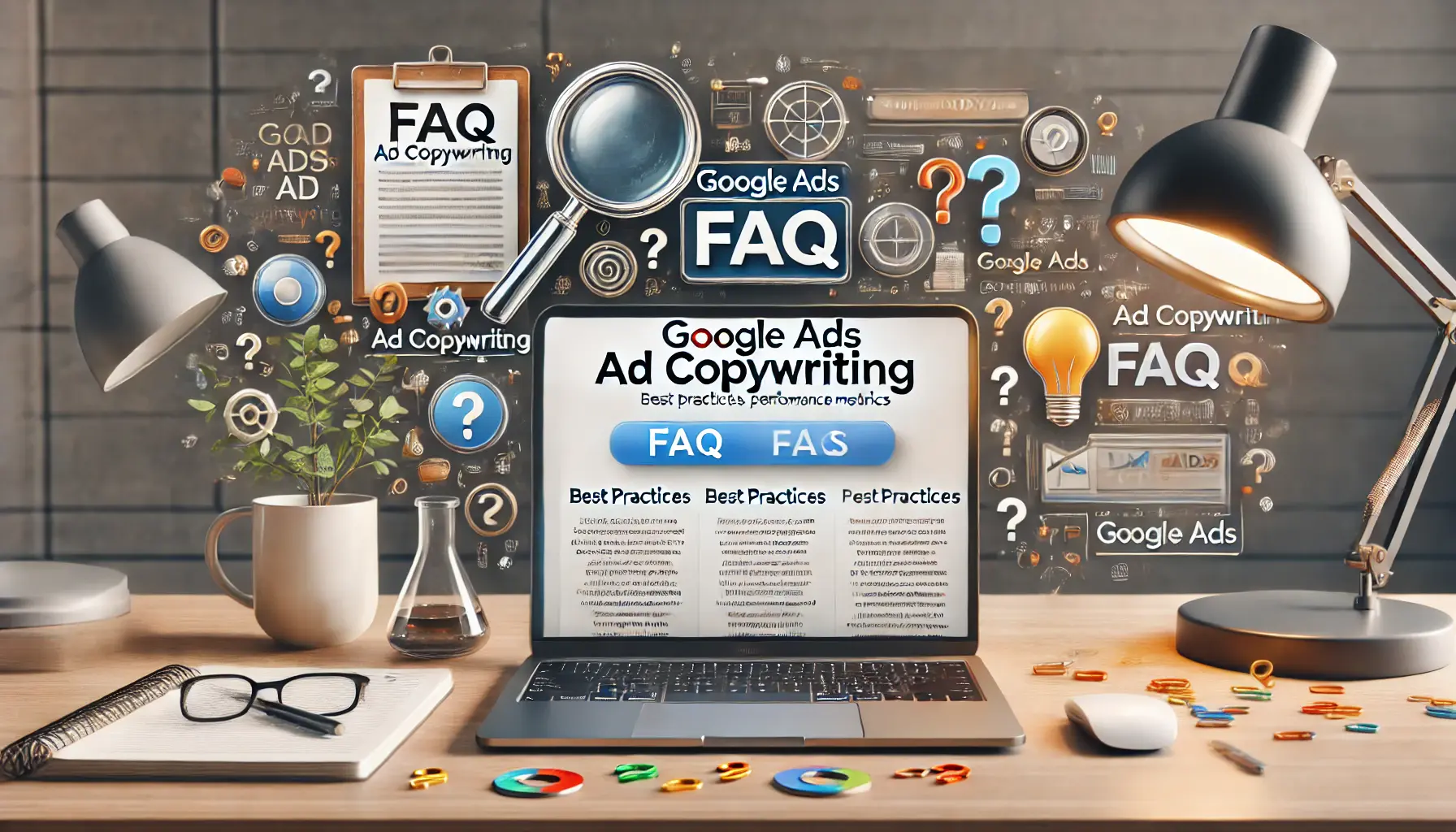
Workspace illustrating the role of FAQs in improving understanding of ad copywriting for Google Ads.
Your campaigns can be managed by an agency specialized in Google Ads, check out our service page.
Google Ads Ad Copywriting FAQs
Below are some of the most common questions related to ad copywriting in Google Ads, covering strategies, tips, and best practices to enhance ad performance and drive conversions.
The role of ad copy is to capture attention, communicate value, and encourage users to take action.
Well-crafted copy leads to higher CTR and conversions, directly impacting the effectiveness of your Google Ads campaign.
To improve CTR, focus on creating relevant and engaging ad copy by aligning with user intent, using emotional triggers, and adding clear CTAs.
A/B testing and performance analysis help identify which copy variations work best.
A good call-to-action is clear, direct, and action-oriented, such as ‘Buy Now,’ ‘Get a Quote,’ or ‘Sign Up Today.’ It guides the user on what to do next and increases the chances of conversion in your Google Ads campaign.
A/B testing allows you to create different variations of your ad copy to determine which performs better.
By testing one element at a time, such as a headline or CTA, you can optimize the ad for better results.
Google’s RSAs allow you to add multiple headlines and descriptions, which are automatically tested in various combinations.
Google uses this data to optimize your ad copy and deliver the best-performing combinations based on search queries.
A high-performing ad headline includes relevant keywords, highlights the unique selling point (USPUnique Selling Proposition, the key feature that differentiates a product or service from its competitors.), and uses action-oriented language.
The shorter and more specific the headline, the better it performs for relevance and CTR.
Alignment between ad copy and landing pages is crucial.
Consistent messaging between the two ensures a better user experience, higher conversion rates, and improved Quality Scores in your Google Ads campaigns.
Quality Score is a metric used by Google to evaluate the relevance of your ad copy, keywords, and landing page.
A higher Quality Score improves ad positioning and reduces CPCCost Per Click, the amount paid by an advertiser each time their ad is clicked., leading to better campaign performance.



